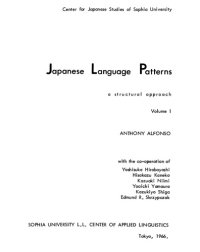
Ebook: Japanese Language Patterns: A Structural Approach, Volume 1
Author: Anthony Alfonso
- Genre: Linguistics // Foreign
- Year: 1966
- Publisher: Sophia University
- Language: English
- pdf
These materials present a new analysis of the Japanese language and a new approach to teaching it. The materials were used successfully by many whose aim it was to so completely master Japanese as to attain not only fluency in the grammatical forms of the language, but also understanding of the thought patterns of the native speakers of the language. The following are the facts and principles considered in the long preparation of these materials.
COMPLEXITY AND SCOPE
Language functions as an organic, but complex unity. It is on account of this complexity that the attention of a beginner cannot be focussed simultaneously on specifically different aspects of a new language. Therefore in the teaching process different aspects should be presented separately, one at a time, until the day comes when all the elements which were learned separately can be reintegrated into one living language. Thus, rather than dealing with all or several of the aspects of the Japanese language in one place, these materials deal primarily with SENTENCE PATTERNS. Sounds, accent, and lexical items are not analyzed here unless they have a bearing on the structure itself. These materials are one section of a full Japanese course which should include Japanese pronunciation, an introduction to the Japanese writing system, and progressive Japanese readers.
JAPANESE LANGUAGE PATTERNS is the most fundamental course, and the one for which the greatest need is being felt today. For this reason it has been prepared for the publisher before the other sections of the complete course. The type of Japanese taught here is STANDARD COLLOQUIAL JAPANESE. Elements of the formal and written language are not treated in this course except for purposes of comparison or recognition.
MOST EFFECTIVE MATERIALS
The adult student, unlike a child, approaches the study of a new language with a set of deeply rooted habits formed according to the patterns of his native language. When these native habits conflict with forms in the new language, the native habits will be a constant source of interference. They will present the problems that block the student's efforts to learn and master the new language. It follows, therefore, that materials based upon a careful descriptive comparison of the linguistic habits of the student's native language with those of the language to be learned will produce the most effective materials for teaching a foreign language...
On the basis of such a careful comparison, then, those structures of the new language will be labeled as "easy" which have a corresponding parallel structure in the language of the student. Those structures of the new language which do not have parallel equivalents, or which have no equivalents at all in the native language of the student, will be considered "problems". In these materials we especially stress this second category since mastering the "problems" means mastering the language. The two languages contrasted in these materials are Japanese and American English. Often enough this contrasting is done explicitly; implicitly, certainly, some contrasting is always present in the selection of the forms, in the manner of presenting them, or in the method of drilling them.
FUNDAMENTAL STEPS
Learning the sentence patterns of a foreign language includes these three fundamental steps.
Understanding the Patterns. In order to understand the pattern, we must consider the form, meaning, and distribution of the pattern. We consider the FORM when we answer the following questions. What are the elements constituting a given structure? What elements can be replaced by what class of words? What elements are optional? How do the elements change in their arrangement and their environment? We consider the MEANING when we consider the cultural world of the people using the language, when we ask how that culture looks at and pictures any reality, what are the social overtones of the structures. Finally, we consider the DISTRIBUTION when we examine when one form is used and when another; when we investigate how far the border lines of one structure reach when compared to those of related structures.
Producing the Patterns. Knowing about the patterns is not synonymous with knowing how to use them at the proper times; just as knowing about the language is not the same as knowing the language. To learn to speak the language naturally one must first drill it artificially under controlled conditions in the classroom and language laboratory by means of carefully planned linguistic drills. A set of carefully selected contrastive examples, presented by the teacher and repeated by the student, is much more effective for mastering a pattern than theoretically worded rules which are easily forgotten. One memorizes "key examples" rather than abstract rules. The effectiveness of a class period is in direct proportion to the amount of time the student spends talking the language. ...
Download the book Japanese Language Patterns: A Structural Approach, Volume 1 for free or read online
Continue reading on any device:

Last viewed books
Related books
{related-news}
Comments (0)